Encapsulation – Canadian Conservation Institute (CCI) Notes 11/10
(PDF Version, 1.22 MB)
CCI Note 11/10 is part of CCI Notes Series 11 (Paper and Books)
Introduction
Encapsulation is a safe and easy procedure commonly used by many museums and archives for storing and protecting frequently handled paper artifacts, such as documents, manuscripts, maps, and plans. Encapsulation has several advantages:
- It allows the artifact to be easily handled and viewed through the transparent encapsulation material.
- It protects the artifact against potential physical damage during display, study, or storage. It is readily and easily reversible.
- It is readily and easily reversible.
- It is easy to apply.
Characteristics of Polyester Film
Polyester film used in encapsulation should be free of plasticisers, surface coatings, and ultraviolet (UV) absorbersEndnote 1. Archival polyester film (polyethylene terephthalate), such as Melinex 516, is a transparent, strong, inert, and durable material suitable for use in encapsulation. Various thicknesses are available. The thickness chosen will largely depend on the size of the artifact: 3 mil (0.003") is standard for most documents and manuscripts, while 7 mil (0.007") is more usual for heavier items such as large maps.
Artifacts Not Suitable for Encapsulation
Because polyester film creates an electrostatic charge, encapsulation is not suitable for artifacts with friable media (e.g., charcoal, chalk, pencil, or pastel drawings; gouache) that will transfer onto the film. Artifacts that are attached to a backing board, that are distorted (i.e., cockled or warped), or that show signs of biological infestation by mould or insects should not be encapsulated.
Preparing Artifacts for Encapsulation
Before encapsulating any artifact, remove loose surface dirt using appropriate erasing compounds (consult CCI Technical Bulletin Nº 11, Dry Methods for Surface Cleaning of Paper). Ensure that all fastening devices, such as paper clips, staples, and pins, are also removed. If an artifact is torn but not fragmented, it may be possible to encapsulate it without repairing it. Studies have indicated that some acidic papers may deteriorate more quickly if they are not deacidified before encapsulationEndnote 2. A paper conservator should be consulted about any artifacts that may require treatment.
Sealing
There are several ways of sealing polyester film. The most common method uses double-sided tape.
The brand most commonly used is 3M Scotch Brand double-sided tape #415. This tape is pressure-sensitive, and is normally used in 6.4 mm (1/4") width. The drawbacks of using tape are that the adhesive is acidic, even when new, and has a tendency to "creep" (i.e., ooze out) so that if the artifact slips in the polyester envelope, the edge may become attached to the adhesive. As a precaution, apply the tape at least 3 mm (0.12") away from the artifact. The advantage of using tape is that it is relatively inexpensive. However, should the envelope become wet (e.g., in a flood), the two layers of polyester film may separate.Endnote 3
Polyester film cannot be fused using conventional heat sources. Various special sealing machines are commercially available.Endnote 4
Ultrasonic welding machines:
These machines convert an electrical impulse into mechanical vibration. The heat generated from this vibration softens the polyester and allows the film to fuse together. Although these machines are expensive, they avoid the use of adhesive tape and they allow many documents to be encapsulated quickly and easily.
Heat-sealing machines:
Several models of heat-sealing machines seal polyester film. One of these machines is also available in a table-top version, which may be suitable for documents of small dimensions.
Making a Polyester Envelope Using Double-Sided Tape
Prior to encapsulation, assemble the following tools and materials:
- polyester film
- double-sided tape (3M #415) 6.4 mm (1/4") width
- grid (graph paper)
- small weight
- scissors
- sharp knife
- ruler
- small squeegee/cheesecloth
- cutting surface (rubber-like self-healing cutting board)
- nail clippers
Select the weight of polyester film most suitable for the artifact that is to be encapsulated. Cut two pieces at least 5 cm (2") larger all around than the overall size of the artifact.
Place one sheet of polyester film on the grid. The grid makes it easier to align the polyester film, the tape, and the document.
Place the artifact in the centre of the polyester film, aligning it with the edges of the grid lines. At this point, it is often necessary to hold the artifact in place with a small weight (Figure 1).
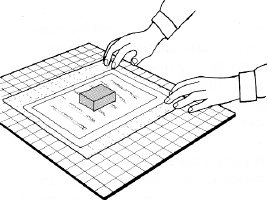
Place double-sided tape along all four sides of the polyester film, about 3 mm (0.12") from the edges of the artifact. Align the tape with the edges of the artifact, and leave a small gap at the corners Endnote 5 (Figure 2). If no space is left, air will be trapped inside the envelope and the corners will tend to pucker. Take particular care to keep the tape straight when working with long artifacts (e.g., maps and plans).
Remove the weight, and place the second sheet of polyester film over the artifact (Figure 3). Replace the weight.
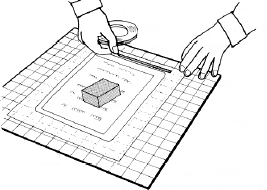
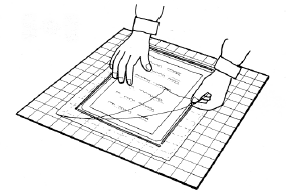
Remove the paper covering the tape, one strip at a time. Smooth out the polyester film with a small squeegee (Figure 4) or with a soft cloth (e.g., cheesecloth) that will not scratch the polyester film. This not only ensures that the tape is well adhered to the polyester film, but also squeezes out the air.
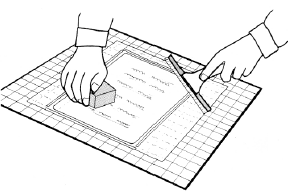
Once all four edges are adhered, use a knife and a straight edge to trim the envelope approximately 3 mm (0.12") from the edge of the tape; a sharp pair of scissors can be used as an alternative (Figure 5).
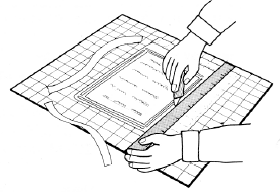
Round the corners, using nail clippers or scissors, to prevent the sharp edges from damaging other artifacts.
Suppliers
Polyester film (Melinex 516):
- Transilwrap of Canada Ltd
333 Finchdene Square
Scarborough, Ontario
M1X 1B9
telephone: 416-292-6000 - Cadillac Plastic Ltd
(Distributor for Transilwrap)
91 Kelfield Street
Rexdale, Ontario
M9W S4A
telephone: 416-249-8311
Branches: Dorval, Vancouver, London, Halifax, Edmonton, Calgary - Commercial Plastics & Supply
47 Survey Crescent
Toronto, Ontario
M6B 1S9
telephone: 416-787-4215
Branches: Ottawa, Montreal, Vancouver - Dupont Division Canada
P.O. Box 26
Toronto Dominion Centre
Toronto, Ontario
M5K 1B6
telephone: 416-362-5621 - Carr McLean
461 Horner Avenue
Toronto, Ontario
M8W 4X2
telephone: 416-252-3371 - University Products of Canada
6535 Millcreek Drive, Unit 8
Mississauga, Ontario
L5N 2M2
telephone: 416-858-7888
toll-free: 1-800-667-2632
fax: 416-858-8586 - Bury Media & Supplies Ltd
(Distributor for University Products)
B-5, 4255 Arbutus Street
Vancouver, B.C.
V6J 4R1
telephone: 604-731-3439/5838
fax: 604-736-7492 - Lowe-Martin Co. Inc.
P.O. Box 8707
Ottawa, Ontario
KIG 3M4
telephone: 613-741-0962 - Norcal Reprographics () Ltd
1180 Winnipeg Street
Regina, Saskatchewan
S4R IJ6
telephone: 306-757-5963 - Woolfitt's Art Enterprises Inc.
390 Dupont Street
Toronto, Ontario
M5R 1V9
telephone: 416-922-0933
fax: 416-922-3017
or
Calgary, Alberta
Telephone: 403-278-0565
fax: 403-278-2050
3M #415 DonbIe-sided tape (1/4" width):
- Carr McLean
University Products of Canada
Lowe-Martin Co. Inc.
Norcal Reprographics () Ltd
Woolfitt's Art Enterprises Inc. - Loomis & Toles Artists Materials
1140 Sheppard Avenue West
Downsview, Ontario
M3K 2A2
telephone: 416-630-6219
fax: 416-630-8349
Branches: Toronto, Halifax,
Encapsulation machines:
- Minter/Malosh Ultrasonic Welder:
William Minter
3605 North Damen Avenue
Chicago, IL
60618 U.S.A.
telephone: 312-248-0624
- Curateur Polyester Sealers
(Curateur, Curateur Compact):Transilwrap du Canada Ltée
131 Barre Street
Ville St-Laurent, Québec
H4T 1W6
telephone: 514-735-5535
fax: 514-735-5862
- Polyweld Sealing Machine Model
B-50, U.S. Patent 4441953, produced
by Conservation Resources International and distributed byArcProtec Inc.
P.O. Box 2506, Station D
Ottawa, Ontario
K1P 5W6
telephone: 613-523-9260
fax: 613-739-1578or
Conservation Resources International, Inc.
8000-H Forbes Place
Springfield, Virginia
22151 U.S.A.
Telephone: 703-321-7730
toll-free: 1-800-634-6932
Cutting board:
- Local artists' suppliers
Further Reading
- Barrios, Pamela. "Encapsulation as Binding," Abbey Newsletter, vol. 13, nº 3 (), pp. 47-49.
- Ellis, Margaret Holben. The Care of Prints and Drawings. Nashville, Tennessee: AASLH Press, , pp. 152-154.
- Library of Congress Preservation Office. Newsprint and Its Preservation. Preservation Leaflet Nº 5. Washington, DC: Library of Congress Preservation Office, .
- Library of Congress Preservation Office. Polyester Film Encapsulation. Washington, DC: Library of Congress Preservation Office, .
- Smith, Merrily A. "From the Mail Bag...," National Preservation News, nº 4 (), p. 9.
- Waters, Peter. "An Assessment of Lamination and Encapsulation," in The Conservation of Library and Archival Materials and the Graphic Arts: Abstracts and Preprints, Cambridge, Society of Archivists and Institute of Paper Conservation, , pp. 74-83.
Copies are also available in French.
Texte également publié en version française.
© Government of Canada,
Cat. Nº NM95-57/11-10-1995E
ISSN 0714-6221